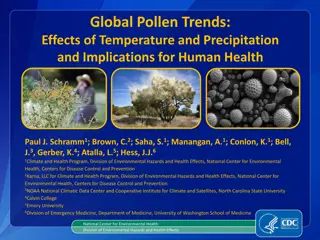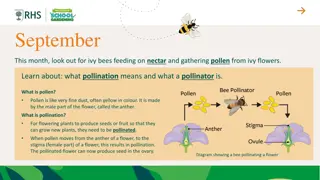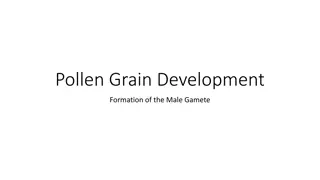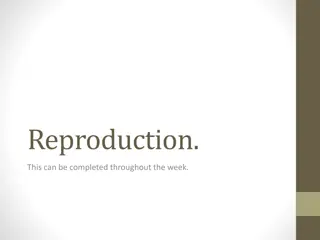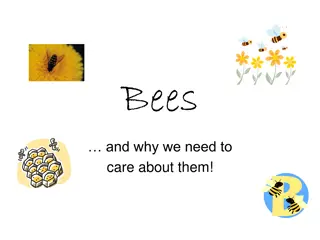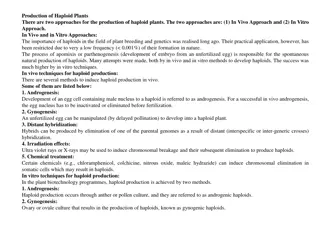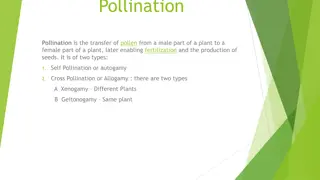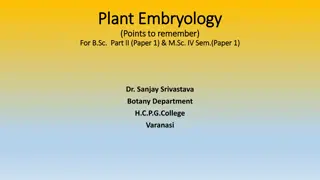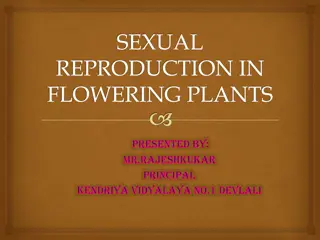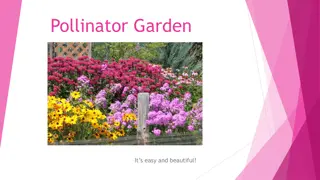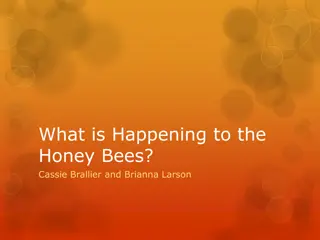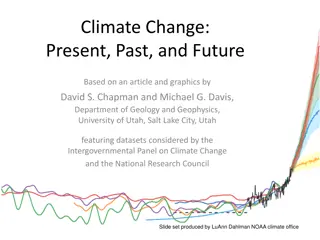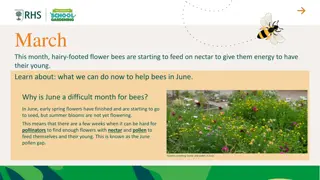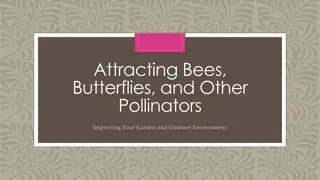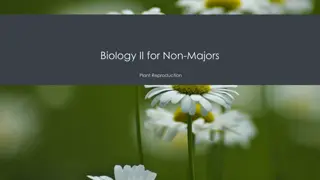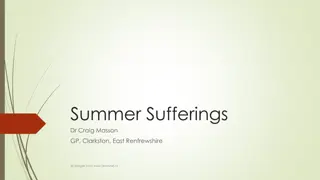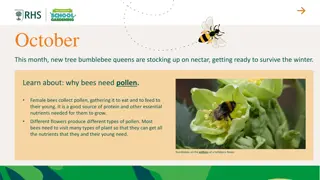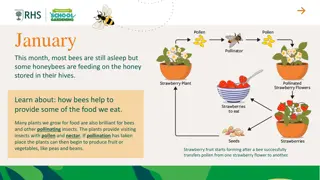Exploring Seed Plant Diversity and Adaptations
Delve into the realm of seed plants, uncovering their unique adaptations for reproduction, their phylogeny with gymnosperms and angiosperms, and the diversity within gymnosperms such as conifers, cycads, gingkophytes, and gnetophytes. Discover the evolutionary success of seed plants through their wa
5 views • 23 slides
Impact of Temperature and Precipitation on Global Pollen Trends and Human Health
Pollen significantly affects millions of Americans with allergic rhinitis, asthma, and respiratory issues, resulting in substantial healthcare costs. This study investigates the effects of temperature and precipitation shifts on pollen production, tracking trends over time through literature reviews
0 views • 15 slides
Understanding Pollination: The Role of Pollinators in Plant Growth
In September, watch out for ivy bees feeding on nectar and gathering pollen from ivy flowers. Explore the significance of pollination, pollen, and pollinators in the plant life cycle. Discover how bees and other pollinators play a crucial role in food production and biodiversity. Engage in activitie
2 views • 9 slides
Ongoing USDA Programs and Biotechnology Research Overview
This overview delves into ongoing USDA programs such as the Biotechnology Risk Assessment Grants (BRAG) Program, which supports biotechnology research. The program covers risk assessment, management, pollen flow research, gene transfer control methods, and more. Additionally, voluntary market facili
0 views • 16 slides
Pollen Grain Development
The process of pollen grain development and formation of the male gamete involves crucial stages such as the presence of diploid microspore mother cells in the stamen, meiosis resulting in the formation of four haploid cells and tetrads, mitosis leading to the development of two haploid nuclei in ea
0 views • 6 slides
Understanding Reproduction: Pollen, Eggs, and Life Cycles in Plants
Reproduction in plants involves the transfer of pollen to eggs, leading to fertilization and the formation of new life. Male animals produce sperm, while females produce eggs, which fertilize when they meet. Different animals exhibit external or internal fertilization, with varying numbers of offspr
1 views • 13 slides
Importance of Bees: Why We Need to Care About Them
Bees are essential pollinators, with various species playing crucial roles in ecosystems. They forage for pollen and nectar, create honey, and live in diverse habitats. Bumble bees, honey bees, and solitary bees each have unique characteristics and contribute to biodiversity. However, bees face thre
6 views • 21 slides
Production of Haploid Plants: Approaches and Significance
There are two main approaches for haploid plant production - in vivo and in vitro methods. Haploids are important in plant breeding but are rare naturally. Various techniques like androgenesis, gynogenesis, distant hybridization, irradiation, and chemical treatments are used to induce haploid produc
0 views • 4 slides
Understanding Pollination: Types and Factors
Pollination is the crucial process of transferring pollen for fertilization and seed production in plants. It can be self-pollination or cross-pollination, with different types of dehiscence affecting how pollen is released. Self-pollination occurs in hermaphroditic and monoecious plants, with facto
0 views • 22 slides
Insights into Plant Embryology: Points to Remember for Botany Students
Explore key points in plant embryology including terminology, structure of anthers, pollen grain formation, pollen viability testing, and aspects of meiosis. Understand the significant contributions of Prof. Panchanan Maheshwari to Indian plant embryology.
0 views • 11 slides
Understanding Sexual Reproduction in Flowering Plants
Explore the fascinating process of sexual reproduction in flowering plants, presented by Mr. Rajeshkukar, Principal of Kendriya Vidyalaya No. 1 Devlali. Discover the parts of a flower, including the androecium and gynoecium, stamen, anther structure, and microsporogenesis. Dive into the intricate de
8 views • 35 slides
Create a Pollinator Garden: Easy and Beautiful Tips
Design your own pollinator garden to attract butterflies, bees, and other pollinators with nectar and pollen sources. Learn about the benefits of native plants, planting strategies, and a variety of flowers to create a vibrant and thriving garden that supports biodiversity.
1 views • 7 slides
Insights on Insecticide Resistance and Monitoring in Agriculture
Discover the latest findings on insecticide resistance and monitoring in agriculture, including data on pollen beetles, cabbage stem flea beetles, and strawberry blossom weevils. Insights from experts in Sweden, Germany, and beyond offer valuable strategies and knowledge-sharing for effective pest m
0 views • 7 slides
The Devastating Impact of Colony Collapse Disorder on Honey Bees
A profound look into the catastrophic effects of Colony Collapse Disorder (CCD) on honey bee populations, causing the loss of millions of beehives and threatening crop pollination. Scientists attribute CCD to a deadly mix of fungicides and pesticides found in pollen samples, disrupting bees' neurolo
0 views • 6 slides
Honey Bee Exposure to Pesticides: Routes and Impacts
Analysis by the U.S. Environmental Protection Agency outlines various exposure routes of honey bees to pesticides, including contact with contaminated sources like foliage and soil, ingestion of contaminated pollen and nectar, and inhalation of chemical droplets. Different application types and age
2 views • 13 slides
Understanding Pollination: How Bees Help Plants Grow
Discover the fascinating relationship between bees and flowers, where bees play a vital role in pollination, aiding in the growth of plants and the production of fruits and seeds. Explore how bees need flowers for pollen and nectar, and how plants rely on bees to spread their pollen for reproduction
0 views • 10 slides
Understanding the Vital Relationship Between Bees and Flowers
Explore the significance of bees in pollination, the role of pollen in flower reproduction, and how bees contribute to plant growth. Dive into the world of nectar collection, honey production, and the mutualistic relationship between insects and flowers. Discover the essential interdependence betwee
0 views • 15 slides
Understanding Climate Change Through Paleoclimatology
This presentation delves into the study of past climates using proxy data such as corals and tree rings. By examining natural recorders like ice cores and fossilized pollen, scientists can reconstruct historical climate variations. The visuals showcase how data from sources like coral cores and tree
0 views • 40 slides
Helping Bees in June: Bridging the Pollen Gap
In June, bees face challenges due to the pollen gap between spring and summer blooms. By sowing flowering plant seeds in March and letting grass patches grow with dandelions and daisies, we can provide vital nectar and pollen sources for bees to thrive. Engage your school community in planting activ
0 views • 8 slides
Plant Tissue Culture Methods for Growth and Reproduction Study
Plant tissue culture methods such as root tip culture, shoot-tip culture, leaf culture, flower culture, and anther and pollen culture allow for the study of growth, reproduction, and genetic variations in plants. These techniques involve culturing various plant parts under sterile conditions to inve
1 views • 20 slides
Enhancing Your Garden for Bees, Butterflies, and Pollinators
Enhance your outdoor space by attracting bees, butterflies, and other pollinators. Plant pollen-rich flowers, avoid harmful chemicals, provide food and water sources, and offer shelter for a thriving pollinator-friendly environment.
0 views • 5 slides
Understanding Asthma: Symptoms, Triggers, and Management in Schools
Asthma is a common condition affecting many individuals, especially in school settings. This training aims to educate on recognizing asthma, providing support during attacks, available treatments, and school responsibilities. Asthma symptoms include coughing, wheezing, chest tightness, and shortness
0 views • 14 slides
Plant Reproduction and Life Cycles in Biology II for Non-Majors
Explore the complex processes of plant reproduction, life cycles, and the alternation of generations in biology. From the fusion of male and female gametes to the development of sporophytes and gametophytes, delve into the stages and structures involved in the reproduction of gymnosperms and angiosp
0 views • 25 slides
Development of Female Gamete and Embryo Sac in Plant Reproduction
In plant reproduction, the formation of female gametes involves meiosis in cells of the carpel sac, leading to the development of the embryo sac or megaspore. Meiosis results in four haploid cells, of which three degenerate, and one survives. This surviving cell undergoes multiple rounds of mitosis,
0 views • 7 slides
Summer Sufferings: Treatment Options for Hay Fever and Related Conditions
Dr. Craig Masson, a GP in Clarkston, East Renfrewshire, discusses prescribing and non-prescribing options for hay fever, sinusitis, prickly heat, urticaria, and Lyme disease. The content covers the challenges of managing hay fever symptoms including grass and pollen allergies, and suggests non-pharm
0 views • 24 slides
Understanding the Importance of Pollen for Bees in October
New tree bumblebee queens in October are busy gathering nectar for winter survival. Discover why bees need pollen, how they collect it, and the vital role it plays in their growth and nutrition. Explore different ways bees carry pollen and engage in a learning activity to spot bees with pollen. Delv
0 views • 7 slides
The Vital Role of Bees in Pollination for Food Production
Bees play a crucial role in pollination, helping to produce a variety of foods like fruits, vegetables, and herbs that end up on our plates. This process involves bees transferring pollen between plants, leading to the development of crops such as strawberries and peas. Without bees and other pollin
0 views • 9 slides

